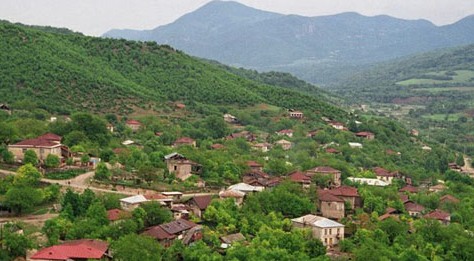Khojavand – 25 years under Armenian occupation

By Rashid Shirinov
October 2 marks the 25th anniversary of the occupation of a beautiful region of Azerbaijan – Khojavand.
The region was occupied by Armenian armed forces during the ferocious Nagorno-Karabakh war. As many as 145 residents of Khojavand died while fighting against the Armenian invasion.
Khojavand was established on the basis of Martuni and Hadrut administrative regions after the Nagorno-Karabakh Autonomous Region of Azerbaijan was abolished in 1991. The region has an area of 1,458 square kilometers and its population was about 41,216 people before the occupation. The region includes Khojavand city, two large settlements Girmizi Bazar and Hadrut, and 81 villages.
The terrain of Khojavand region is mostly mountainous – its height varies from approximately 500 to 2,800 meters. The region has Kurichay, Chaylukh, Aghoghlanchay and some other rivers.
Prior to the occupation, Khojavand was mainly an agricultural region. People were engaged in livestock, viticulture, poultry, crop production, vegetable and fruit growing. Khojavand was also famous for its green marble.
After the invasion into Khojavand and its occupation, Armenians destroyed the region’s infrastructure and depleted its flora and fauna. Data by the Center evaluating the damage inflicted to the environment and natural resources in the Azerbaijani occupied territories says that the enemy has turned the area into a drug plantation. The drug crops planted by Armenians in Khojavand are currently delivered to a number of countries.
Armenian invaders plundered natural recourses of the region – they cut down trees and transported them to Armenia and other countries as construction materials.
The Ministry of Ecology and Natural Resources reported that in Khojavand there are lime fields of 989,000 tons of underground water with the predicted reserve of 90,000 cubic meters daily.
Near the Gyrmyzy (Red) Bazaar settlement, there were two samples of plane tree of 600 cm in diameter and 25 m in height, preserved as natural monuments. They were at the age of 1000 and 2000 years, while in Garakand village there was the forest reserve of 0.5 hectares with trees included into the Red Book and representing the tertiary period relict. In Khojavand, the forests of 25.5 hectares dominated by oaks were cut by Armenian occupants.
Khojavand also had many historical, archaeological and architectural monuments. These are the ancient Azykh Cave, dating back almost 1.5 million years B.C., which includes six caves where primitive people lived, as well as in the Taghlar Cave, a lot of fortresses of 1-8th centuries, an Albanian Temple of the 10th century, a13th century tomb and many other ancient monuments.
Today, 20 percent of Azerbaijani lands, including Kohajvand, illegally remain under Armenian occupation. The Nagorno-Karabakh war, which began in 1988, is still unresolved, and this upsets more than a million of Azerbaijani internally displaced persons, who had to leave their homes in Nagorno-Karabakh and other occupied regions due to the Armenian aggression.
Azerbaijan has long ago stated it is ready to settle the conflict through direct negotiations with Armenia with mediation of the OSCE Minsk Group, which was created to resolve this conflict. However, the Armenian side is constantly trying to make up reasons to avoid a constructive dialogue and preserve the unacceptable status quo in Nagorno-Karabakh.
---
Rashid Shirinov is AzerNews’ staff journalist, follow him on Twitter: @RashidShirinov
Follow us on Twitter @AzerNewsAz
